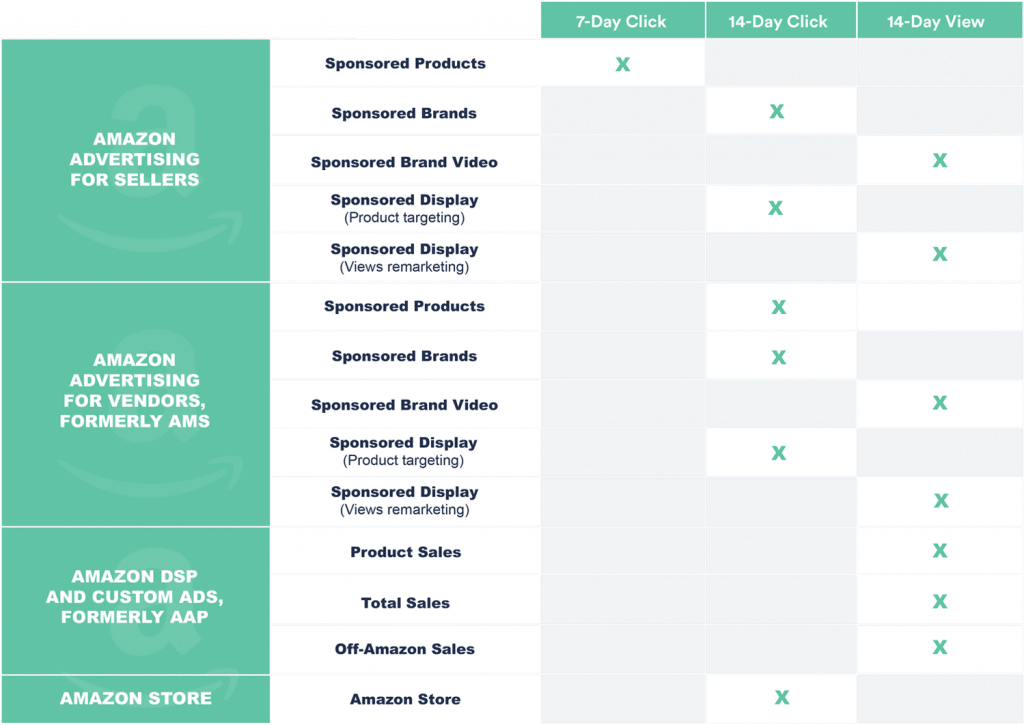Ever wondered why your Amazon Sponsored Product campaign promoting a £10 item is showing a sale of £15? Ever taken a second look at your advertising data and noticed that the numbers have changed?
The answer to both of these scenarios lies in attribution.
Keep scrolling for a comprehensive, up-to-date guide on Amazon’s attribution model.
What is Ad Attribution?
In a nutshell, attribution is the act of assigning a conversion to a particular campaign. Without it, it’s difficult to make informed advertising decisions, because you don’t know the true value of each campaign. You’d essentially be taking a stab in the dark instead of making data-driven optimisations.
The Amazon Advertising Attribution Model
To make things difficult, Amazon offers a multi-layered attribution model that differs vastly from other platforms such as Facebook and Google.
Broadly speaking, there are four advertising routes under the Amazon umbrella and each one tracks attribution differently:

Please note, accessing through the API allows you to choose from 7, 14 or 30 days regardless of these default report timings
Last Click / View Attribution
Now that you’ve got a grasp of the basics, let’s delve a little deeper. With last-click attribution, the last ad that a user interacts with will get credit for the sale.
For Sponsored Product campaigns made by 3rd party sellers, there is a seven-day window. So if a shopper clicks on your ad and returns within seven days to make a purchase, the sale will be attributed to the original ad. If the sale falls outside of these seven days, it doesn’t count. It’s that simple.
The same principle applies to Sponsored Product campaigns created by first party vendors. The only difference is that the attribution window is extended to 14 days, instead of the usual seven days.
But that’s not all, as this strategy changes again when it comes to Sponsored Brand Video, Sponsored Display Remarketing, and DSP ads. Thankfully, the underlying premise remains the same.
Rather than a last-click model, these ads operate on a last view model. In practice, this means that the last Sponsored Brand Video that a shopper watches before converting will get credit for the sale.
If you’re an accomplished advertiser, last click/view attribution is nothing new. But this doesn’t mean it is without flaws. In fact, most other platforms have moved away from this model as it can be seen as overly simplistic.
Nowadays, consumers are interacting with brands through multiple touchpoints before converting. That is, the customer journey is rarely limited to one touchpoint. So is it fair that one campaign from one channel receives 100% of the credit for the sale? Probably not.
Halo Sales
To complicate things even further, Amazon’s attribution model also incorporates halo sales. This refers to sales of products that you aren’t actively promoting in a given campaign.
Let’s say you have a Sponsored Product campaign promoting a pair of sandals. A shopper discovers your brand by clicking on the sandals ad, but after browsing they decide to purchase a handbag from your brand instead. Even though the handbag was not part of the original sandals campaign, it will receive credit for the sale because this ad acquired the last click.
There are perks and drawbacks to this approach. Firstly, halo sales encourage you to analyse your advertising efforts holistically. They measure the impact of your ads on your entire portfolio. Is one campaign responsible for the majority of your ad sales? Is one product driving ad visibility?
But the downside of this is lack of clarity. If you have several brands operating under one account, any sales from any brand can be attributed to a campaign.
To some degree, this can be clarified by downloading your ‘advertised product’ and ‘purchased product’ reports. These outline what proportion of sales went to the advertised product and what proportion went to other SKUs. Unfortunately, that’s all the information that Amazon is willing to offer.
Final Thoughts
A good understanding of Amazon’s multi-layered attribution model is vital if you want to build strong advertising campaigns. Although last click/view attribution seems pretty basic, there are several caveats that you can’t afford to dismiss.
If attribution isn’t your forte and you’d prefer to leave it to the experts, drop us a message and let’s get chatting.


